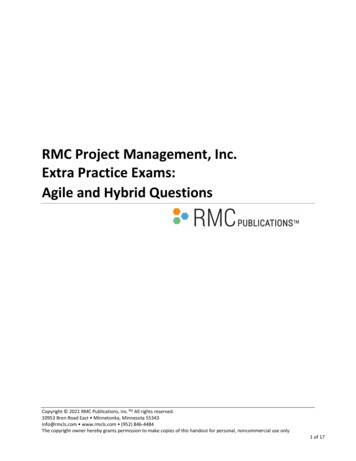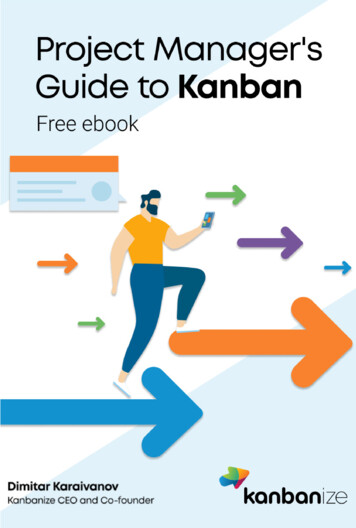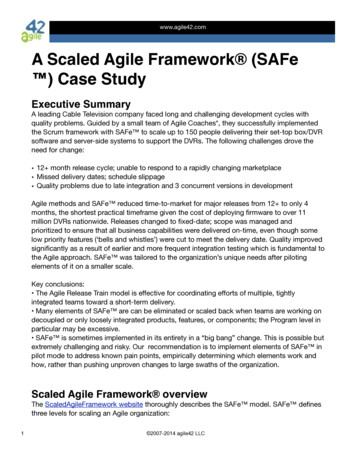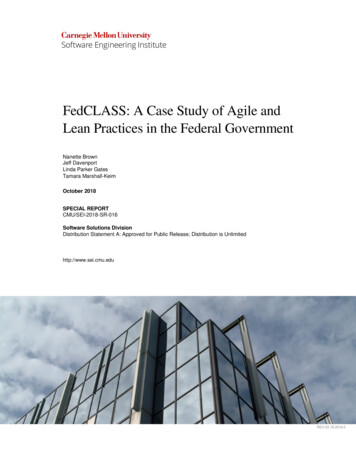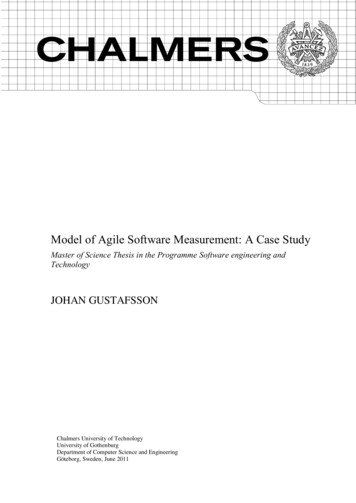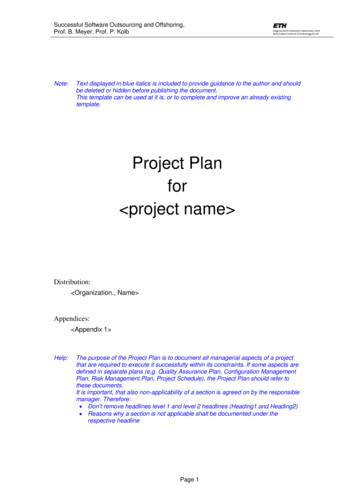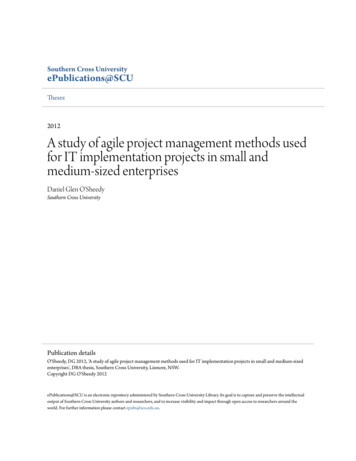
Transcription
Southern Cross UniversityePublications@SCUTheses2012A study of agile project management methods usedfor IT implementation projects in small andmedium-sized enterprisesDaniel Glen O'SheedySouthern Cross UniversityPublication detailsO'Sheedy, DG 2012, 'A study of agile project management methods used for IT implementation projects in small and medium-sizedenterprises', DBA thesis, Southern Cross University, Lismore, NSW.Copyright DG O'Sheedy 2012ePublications@SCU is an electronic repository administered by Southern Cross University Library. Its goal is to capture and preserve the intellectualoutput of Southern Cross University authors and researchers, and to increase visibility and impact through open access to researchers around theworld. For further information please contact epubs@scu.edu.au.
A Study of Agile Project Management Methods used forIT Implementation Projects in Small and Medium-sizedEnterprises.Daniel G. O’SheedyB Info Tech, Central Queensland UniversityMBA (Technology Management), Chifley Business School/La Trobe UniversityA Research Thesis Submitted in Partial Fulfilment of the Requirementsfor the Degree of Doctor of Business AdministrationSouthern Cross UniversityNovember, 2011Southern Cross UniversityStudent Number: 21654776Supervisor: Dr Jun Xu, Southern Cross UniversityCo-Supervisor: Dr Shankar Sankaran, University of Technology Sydney
AbstractProject management methods have been developed from industry practices andinternational standards to ensure a higher rate of success for information technologyprojects. These have been widely used in large organisations effectively. However, whenprojects are implemented in a small or medium-sized enterprise environment, there is oftena lack of an established method of project management or skilled project implementerswho can use methods used in large organisations. As project workers find themselvespressured to become more responsive to business demands, it is becoming commonplacefor smaller organisations to forgo formal project management practices. This is often dueto the fact that small projects are viewed as simple to deploy, suffer from a lack ofresources, or are given low prioritisation by the organisation. Additionally, the currentproject management standards are frequently perceived by SMEs as complicated andoverly bureaucratic, something undesirable in regards to time-constrained or low-budgetprojects. Agile development is one solution to the problem of overly complex methods thathas recently been adopted in the field of software production, and has gained considerablepopularity with smaller organisations.This research investigates the current state of formalised project management and howthese methods could be modified for a small or medium-sized enterprise, especially inrelation to information technology implementation projects. A mixture of traditionalproject management methods and newer agile development methods were utilised, withthe goal of establishing that a combination of the two methods that can assist with projectsuccess, particularly in the case of resource-poor medium-sized organisations. Theacceptance of this method by the technology workers and stakeholders involved was alsoinvestigated. In an economic age where businesses are required to do more with less, aproject management method that can help with successful implementation could provebeneficial to many organisations of this size. Arising out of agile development, agileproject management has great potential to fill this role, and it was with this goal in mindthat this research was conducted.KeywordsAgile, project management, scope change, unstable environment, PMBOK, Scrum, SME,small projects, hybrid project management, changing requirements.ii
Table of Contents1. Chapter 1 - Introduction . 11.1. Background to the research . 11.2. Research problem and propositions. 31.3. Justification for the research . 41.4. Research methodology . 81.5. Outline of the research report . 111.6. Key definitions . 121.7. Delimitations of scope and key assumptions . 131.8. Conclusion . 142. Chapter 2 – Literature review . 162.1. Introduction . 162.2. Parent discipline 1: Project management. 182.2.1. Definitions of project management . 182.2.2. A history of project management . 202.2.3. The major project management schools of thought are established . 262.2.4. The progress of project management research . 302.2.5. Determining if project management provides value to an organisation . 332.2.6. Project management basics . 352.2.7. Major project management standards in use today . 372.2.8. Research into small projects starts to increase . 462.3. Parent discipline 2: Software development . 462.3.1. The progression of software development. 47iii
2.3.2. Software development standards: Their strengths and weaknesses . 512.3.3. Agile software development is introduced . 542.4. Parent discipline 3: Small and medium-sized enterprises - the challenges . 592.4.1. The importance of SMEs, and the unique challenges they can encounter . 592.4.2. The importance of technology in an SME organisation . 612.4.3. The importance of IT strategy and planning in an SME organisation. 652.4.4. IT and the Austrian SME . 702.5. Immediate discipline: IT projects in an SME environment . 722.5.1. The current state of IT project management in SME environments. 722.5.2. The way forward: An amalgamation of formal and agile methods . 742.6. Conclusion . 783. Chapter 3 - Methodology. 813.1. Introduction . 813.2. A detailed description of the research environment . 833.3. Justification for the paradigm and methodology chosen . 853.3.1. The reasons why action research was the methodology chosen . 863.3.2. The major research paradigms explained . 863.3.3. The clash between positivism and interpretivism. 883.3.4. Establishing a research theoretical framework . 883.4. The research procedure explained . 903.4.1. The main goals of action research . 903.4.2. The argument for using action research as a research methodology . 903.4.3. Potential problem sources in action research . 91iv
3.4.4. The origins of action research . 923.5. Implementation of the action research. 953.5.1. Phase 1 – Initial interviews . 973.5.2. Phase 2 – Research objectives defined . 983.5.3. Phase 3 – Project work . 993.5.4. Phase 4 – Participant consultation and feedback . 993.5.5. Phase 5 – Project work . 1003.5.6. Phase 6 – Participant consultation and feedback . 1003.5.7. Phase 7 – Project work . 1013.5.8. Phase 8 – Participant feedback and report preparation. 1013.6. Data collection and coding . 1013.7. Justification of sample selection . 1033.7.1. Quantitative sample size . 1053.8. Limitations of the methodology . 1063.9. Ethical considerations and cultural implications . 1073.10. Conclusion . 1094. Chapter 4 – Data analysis . 1114.1. Introduction . 1114.1.1. Qualitative data collection, coding and categorising . 1134.2. Pilot interviews . 1144.2.1. Details and researcher assumptions . 1144.2.2. Primary findings from this phase . 1164.2.3. Research adjustments . 116v
4.3. The project management framework design process . 1174.3.1. The core processes of the project management framework . 1174.3.2. Description of the project management framework . 1204.4. Action research: the initial test and design cycles . 1224.4.1. Details and researcher assumptions . 1224.4.2. Primary findings from this phase . 1234.4.3. Research adjustments . 1274.5. Action research cycle 1. 1284.5.1. Details and assumptions . 1284.5.2. Primary findings from this phase . 1294.5.3. Research adjustments . 1314.6. Interim survey . 1324.6.1. Details and assumptions . 1324.6.2. Testing the hypotheses . 1334.6.3. Research adjustments . 1414.7. Action research cycle 2. 1434.7.1. Details and assumptions . 1434.7.2. Primary findings from this phase . 1444.7.3. Research adjustments . 1464.8. Action research cycle 3. 1474.8.1. Details and assumptions . 1474.8.2. Primary findings from this phase . 1474.8.3. Research adjustments . 151vi
4.9. Conclusion . 1535. Chapter 5 – Conclusion . 1555.1. Introduction . 1555.2. Conclusions about the research questions . 1585.2.1. What tools and procedures will need to be included in a toolkit, combiningmethods to assess the primary research question?. 1595.2.2. What are the results of implementing this toolkit in an SME environment? . 1605.2.3. To what extent can a mixture of traditional project management methods andagile development methods improve IT project success in an SME environment? . 1605.3. Implications for theory . 1615.3.1. The benefits of a flexible agile project management framework . 1615.3.2. Agile project management is flexible, but cannot solve all problems . 1625.3.3. Issues that can occur when introducing a new project management style . 1645.3.4. Coping with change, when change is a requirement . 1665.3.5. The project manager holds a central role in the success of projects. 1675.4. Implications for project management policy and practice. 1695.4.1. An agile project management framework allows project teams to adapt . 1695.4.2. Responsiveness to requirement changes improves when using agile methods. 1705.4.3. Practice, practice, practice: 10,000 hours . 1715.4.4. A compact team structure produces the best results . 1745.4.5. Findings about the agile project management framework. 1765.5. Conclusions and recommendations arising from the research . 179vii
5.5.1. There are real benefits to be gained from implementing an agile projectmanagement style. . 1825.5.2. Agile project management needs the support of the business owners, especiallyin an SME environment. . 1825.5.3. Agile project management is better suited to smaller environments . 1825.5.4. Agile is not a panacea, and needs to be used as a tool in a suitable setting . 1835.5.5. The agile project management framework must be adjusted to the companystructure and culture to work most efficiently . 1835.5.6. The framework must be customised, incorporating elements of both agile andPMBOK . 1845.5.7. Small teams work best in an agile environment, though teams can scale forlarger projects by adding extra teams . 1845.5.8. To become a skilled project manager requires many hours of experience andtraining . 1855.5.9. The project manager’s management style needs to be matched to the project,and they need to be trained in this role . 1855.6. Researcher’s thoughts about personal development . 1865.7. Limitations of the research . 1885.8. Further research potential in this field . 1905.8.1. Further investigation of agile project management . 1905.8.2. Determining the best organisational culture fit for agile project management 1915.8.3. The development of a PMBOK Lite. 1925.9. Conclusion . 193viii
List of TablesTable 1: Project management research, categorised and separated into decades . 32Table 2: The summarised details and results from the pilot interviews . 114Table 3: The summarised primary findings from the initial test and design cycles . 122Table 4: The summarised primary findings from action research cycle 1 . 128Table 5: The summarised primary findings from the interim survey . 132Table 6: The correlation between risk and project fundamentals . 134Table 7: The correlation between risk and change reaction . 135Table 8: The correlation between risk and training . 136Table 9: The correlation between training and project fundamentals . 137Table 10: The correlation between change and change reaction . 138Table 11: The correlation between company culture and teamwork . 139Table 12: The correlation between company culture and change reaction . 140Table 13: The summarised primary findings from action research cycle 2 .
MBA (Technology Management), Chifley Business School/La Trobe University A Research Thesis Submitted in Partial Fulfilment of the Requirements for the Degree of Doctor of Business Administration Southern Cross University November, 2011 Southern Cross University Student Number: 21654776 Supervisor: Dr Jun Xu, Southern Cross University


